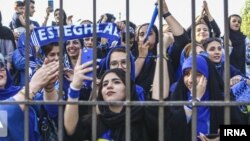
A 29-year-old Iranian woman has died after setting herself alight after being charged for trying to attend a men's soccer match.
Sahar Khodayari, a soccer fan nicknamed "The Blue Girl" after the colors of her favorite team, Esteghlal, died in a Tehran hospital, Iranian media reported on September 9.
Unconfirmed reports suggested that she died over the weekend but that her death had been announced on September 9 after her burial under tight security measures in the holy Shi'ite city of Qom.
Khodayari's death comes days after she poured gasoline on herself and set herself alight outside a court on September 2 where she had been summoned after being charged following an attempt to enter a sports stadium to watch a soccer game.
She reportedly had burns over 90 percent of her body and her lungs had been badly damaged.
Her sister said that Khodayari suffered from bipolar disorder and that she had attempted suicide in the past.
Khodayari's sister told Iranian media that her mental state had deteriorated following her arrest and after hearing that she could be jailed for six months.
The woman said her sister attempted in mid-March to sneak into a soccer match at Tehran's Azadi Stadium while wearing a blue wig and wearing a long coat.
Khodayari told security guards that she was a woman after they tried to search her, according to her sister.
"They arrested her right there," she said in a September 5 interview with Shahrvandonline.ir.
Khodayari's arrest, her attempted suicide, and her death have led to an outcry on social media and condemnation of a state ban on female spectators that has been enforced for nearly four decades.
In the past, only selected groups of women have been allowed into stadiums to watch soccer matches or other men's sporting events.
Devoted female soccer fans have managed to defy the ban on rare occasions by disguising themselves as men.
"She was the daughter of Iran," Iranian lawmaker Parvaneh Salahshouri said, adding "in a place where men decide for women and deprive them of their most basic rights and women go along this blatant injustice by men."
"We're all responsible for the imprisonment and the burning of the Sahars of this country," Salahshouri said on Twitter.
Several Esteghlal players grieved Khodayari's death on social media while expressing "shame" over her plight.
National team player Hossein Mahini shared a drawing by renowned soccer cartoonist Omar Momani in tribute to Khodayari.
An unnamed official was quoted last week by media as saying the young woman had been arrested for not being sufficiently veiled and for clashing with security guards.
He said her court hearing did not take place because the judge assigned to the case was not present.
Khodayari's death comes amid pressure on Iran by soccer's world governing body, FIFA, to abolish -- or at least relax -- the ban that Iranian officials have enforced for nearly 40 years on women attending men's sporting events.
On August 25, Iran finally relented when Deputy Sports Minister Jamshid Tahizade announced that women would be allowed to attend Iran's World Cup qualifying match against Cambodia.
Human Rights Watch director of global initiatives Minky Worden said on Twitter that FIFA chief Gianni Infantino had not applied enough pressure on Iran to stop the abuses.
"It was predictable decades of women protesting #Iran's stadium ban could end in catastrophe," Worden said while asking FIFA to confirm actions it will take after the tragic death of Khodayari.
"We are aware of that tragedy and deeply regret it," FIFA's media department said in comments sent to RFE/RL. "FIFA convey our condolences to the family and friends of Sahar and reiterate our calls on the Iranian authorities to ensure the freedom and safety of any women engaged in this legitimate fight to end the stadium ban for women in Iran."









